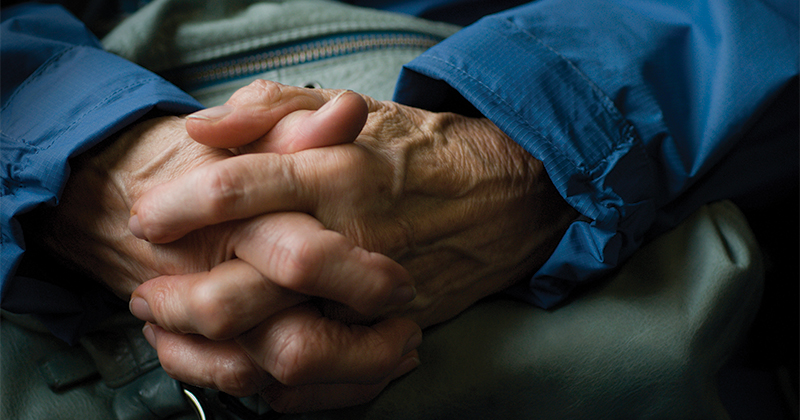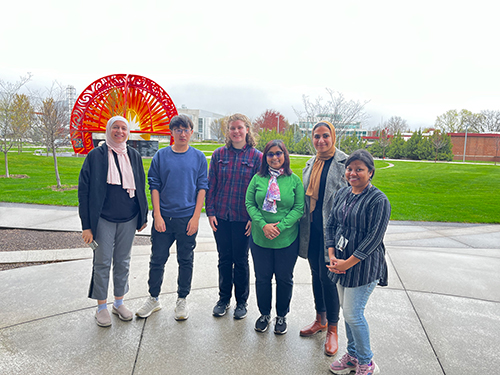Purdue Health Sciences researcher’s innovative metabolic network makes advances toward Alzheimer’s disease treatments
Written By: Rebecca Hoffa, rhoffa@purdue.edu

Alzheimer’s disease is one of the top ten leading causes of death in the United States, according to the Alzheimer’s Association, and the number of millions of people affected by it each year continues to rise. The prevalence of the disease, the lack of treatments and knowledge gap, and an interest in how the brain functions led Priyanka Baloni, assistant professor in the Purdue University School of Health Sciences, on a quest to understand possible treatments for the condition.

Priyanka Baloni(Photo provided)
In doing so, Baloni built the first-ever human brain region-specific metabolic network, which maps out the genes, metabolites, molecules and proteins in seven different regions of the brain. This work was published in Cell Reports Medicine. This has allowed her to pinpoint areas in the brain that could correlate to the development of Alzheimer’s disease and influence potential treatment options.
“Using the multi-omic data, or this gene/protein/metabolite data, we can identify what kinds of processes are going up or down in Alzheimer’s patients,” Baloni said. “It’s not just the genetics that are influencing the disease. It’s more about the metabolic capability of an individual that is related to the disease trajectory. We are now focusing on some of the metabolic signatures that are different between Alzheimer’s disease patient versus a cognitively normal individual.”
A computational biologist in the College of Health and Human Sciences, Baloni often uses data gathered in collaboration with the Alzheimer’s Disease Metabolomics Consortium, of which she is a member, in her work. The consortium, led by professor Rima Kaddurah-Daouk from Duke University, is part of the Foundation for the National Institutes of Health’s Accelerating Medicines Partnership Alzheimer’s disease program. Baloni and the consortium use postmortem human brain samples to collect data on the differences between the brains of individuals who had Alzheimer’s disease with those who did not experience the neurodegenerative disease.
Baloni noted that one particularly significant finding in her Alzheimer’s research has stemmed from a 2020 study funded by the National Institute on Aging looking at primary bile acids, which are produced by the liver, and secondary bile acids, which are produced by the gut microbiome. In the study, Baloni identified secondary bile acids in the brain of individuals with Alzheimer’s disease was significantly higher than in the brain of a person without the disease. Individuals with Alzheimer’s disease also had disproportionate levels of secondary bile acids compared to primary bile acid levels.
This suggests the gut microbiome has a direct impact on the brain and disease development. Baloni explained that because of associations like this, there has been a shift among Alzheimer’s disease researchers to focus on identifying proteins and metabolites that can be tested in the clinic.
“This is not just in Alzheimer’s disease,” Baloni said. “We have found this connection in Parkinson’s disease also. Recent studies on neurodegenerative diseases are focusing on studying the gut and the brain axis and how it’s impacted in the diseased state.”
Baloni has progressed her research to look at other connections to Alzheimer’s disease and certain metabolites in the brain. Another study also funded by the National Institute on Aging explored levels of ceramides, a lipid class associated with inflammation, and sphingomyelins, a type of sphingolipid that connects to the neurons.
“I wanted to find what kind of trigger is set in the case of Alzheimer’s that changes this balance between ceramides and sphingomyelins,” Baloni said. “As part of the collaborative effort with the consortium, I looked into the data from the brain of Alzheimer’s patients as well as cognitively normal individuals, and using the model I had constructed, I looked at specific points in the pathway that are important and can be targeted.”
Through this, Baloni and her collaborators were able to find an FDA-approved drug for relapsing-remitting multiple sclerosis — Fingolimod — that balanced the levels of ceramides and sphingomyelins in individuals with Alzheimer’s disease, and upon testing it in mouse models, were able to show cognitive improvements.
However, Baloni noted because of the significant side effects of the drug, they’re now investigating alternatives that may have reduced side effects and a greater impact on individuals with Alzheimer’s disease specifically.
While Baloni’s research has made strides toward treatments of Alzheimer’s disease through the ability to classify individuals with Alzheimer’s disease based on similarities in their metabolic characteristics, a universal treatment or potential cure has not yet been reached.
“Alzheimer’s is a multimodal disease, so it’s not a ‘one drug fixes all’ kind of thing,” Baloni said. “There is so much heterogeneity in the Alzheimer’s patient population that there’s not just one drug that would have an impact on all Alzheimer’s patients. My research has actually pinpointed a few druggable targets that can be used for treatment purposes.”

Baloni (third from right) poses with the students in her lab.(Photo provided)
For Baloni, it’s the thrill of influencing treatment options in clinical settings that continues to fuel her interest in the field.
“These challenges of identifying potential treatment options are what keep me motivated doing the research,” Baloni said.
Baloni is continuing to expand her research with Alzheimer’s disease, as she currently explores mitochondria, a cellular organelle that is involved in the body’s bioenergetic functions, and the role of its dysfunction in Alzheimer’s disease. Her graduate student Boyu Jiang is pursuing the effort of generating the computational model for human neurons.
Additionally, through her Showalter Early Career Award, Baloni is extending her work to the environmental exposures, including chemicals such as PFAS and heavy metals such as lead and mercury, that are involved in causing neurotoxicity and may potentially play a role in neurodegenerative diseases. Her graduate student Esraa Gabal has been developing in silico tissue-specific metabolic models to study the effect of PFAS in model organisms.
The Showalter award helped Baloni collaborate with ecotoxicologist Maria Sepulveda in Purdue’s Department of Forestry and Natural Resources and neurotoxicologist Jason Cannon in Purdue’s School of Health Sciences to conduct research on the impact of toxic exposure on neurologic functions in model organisms.
“It’s an emerging field, but we know that a lot of environmental exposures are impacting the kinds of interactions that occur in the body and then link to neurodegenerative diseases,” Baloni said.
Discover more from News | College of Health and Human Sciences
Subscribe to get the latest posts sent to your email.